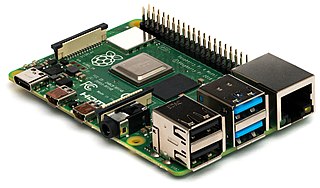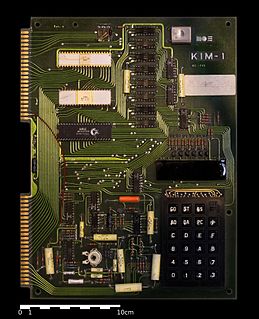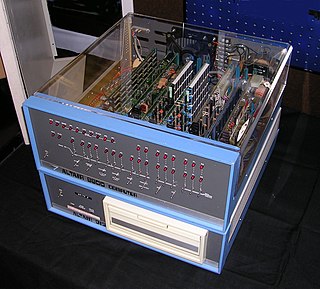
The Apple II is an 8-bit home computer and one of the world's first highly successful mass-produced microcomputer products. It was designed primarily by Steve Wozniak; Steve Jobs oversaw the development of the Apple II's foam-molded plastic case and Rod Holt developed the switching power supply. It was introduced by Jobs and Wozniak at the 1977 West Coast Computer Faire and marks Apple's first launch of a personal computer aimed at a consumer market—branded toward American households rather than businessmen or computer hobbyists.

The MOS Technology 6502 is an 8-bit microprocessor that was designed by a small team led by Chuck Peddle for MOS Technology. The design team had formerly worked at Motorola on the Motorola 6800 project; the 6502 is essentially a simplified, less expensive and faster version of that design.

The 6800 is an 8-bit microprocessor designed and first manufactured by Motorola in 1974. The MC6800 microprocessor was part of the M6800 Microcomputer System that also included serial and parallel interface ICs, RAM, ROM and other support chips. A significant design feature was that the M6800 family of ICs required only a single five-volt power supply at a time when most other microprocessors required three voltages. The M6800 Microcomputer System was announced in March 1974 and was in full production by the end of that year.

The Motorola 6809 ("sixty-eight-oh-nine") is an 8-bit microprocessor CPU with some 16-bit features from Motorola. It was designed by Terry Ritter and Joel Boney and introduced in 1978. A major advance over both its predecessor, the Motorola 6800 and the related MOS Technology 6502, it found use in the TRS-80 Color Computer and Dragon 32/64 home computers, the Vectrex game system, and early 1980s arcade machines including Star Wars, Defender, Robotron: 2084, Joust, and Gyruss. Series II of the Fairlight CMI digital audio workstation and Konami's Time Pilot '84 arcade game each use dual 6809 processors.

A microcomputer is a small, relatively inexpensive computer with a microprocessor as its central processing unit (CPU). It includes a microprocessor, memory and minimal input/output (I/O) circuitry mounted on a single printed circuit board (PCB). Microcomputers became popular in the 1970s and 1980s with the advent of increasingly powerful microprocessors. The predecessors to these computers, mainframes and minicomputers, were comparatively much larger and more expensive. Many microcomputers are also personal computers.

Tiny BASIC is a family of dialects of the BASIC programming language that can fit into 4 or fewer KBs of memory. Tiny BASIC was designed in response to the open letter published by Bill Gates complaining about users "pirating" Altair BASIC, which was sold for $150. The Tiny BASIC language was specified first and then programmers were invited to implement it for different microprocessors and to share their source code openly. Dr. Li-Chen Wang, author of Palo Alto Tiny BASIC, coined the term "copyleft" to describe this. Tiny BASIC is an example of a free software project that existed before the free software movement. Community response to Tiny BASIC was so overwhelming that what had been planned as three newsletters was relaunched as Dr. Dobb's Journal, the first regular periodical to focus on microcomputer software, which lasted in print form for 34 years.

The KIM-1, short for Keyboard Input Monitor, is a small 6502-based single-board computer developed and produced by MOS Technology, Inc. and launched in 1976. It was very successful in that period, due to its low price and easy-access expandability.

The Altair 8800 is a microcomputer designed in 1974 by MITS and based on the Intel 8080 CPU. Interest grew quickly after it was featured on the cover of the January 1975 issue of Popular Electronics and was sold by mail order through advertisements there, in Radio-Electronics, and in other hobbyist magazines. The Altair is widely recognized as the spark that ignited the microcomputer revolution as the first commercially successful personal computer. The computer bus designed for the Altair was to become a de facto standard in the form of the S-100 bus, and the first programming language for the machine was Microsoft's founding product, Altair BASIC.

Southwest Technical Products Corporation, or SWTPC, was a US producer of electronic kits, and later complete computer systems. It was incorporated in 1967 in San Antonio, Texas, succeeding the 1964 DEMCO. Around 1990, SWTPC became Point Systems, before ceasing a few years later.
The Open Letter to Hobbyists is a 1976 open letter written by Bill Gates, the co-founder of Microsoft, to early personal computer hobbyists, in which Gates expresses dismay at the rampant software piracy taking place in the hobbyist community, particularly with regard to his company's software.
A custom-built or homebuilt computer is a computer assembled from available components, usually commercial off-the-shelf (COTS) components, rather than purchased as a complete system from a computer system supplier, also known as pre-built systems.

The Apple II Plus is the second model of the Apple II series of personal computers produced by Apple Computer, Inc. It was sold from June 1979 to December 1982. Approximately 380,000 II Pluses were sold during its four years in production before being replaced by the IIe in 1983.

A microprocessor development board is a printed circuit board containing a microprocessor and the minimal support logic needed for a computer engineer to become acquainted with the microprocessor on the board and to learn to program it. It also served users of the microprocessor as a method to prototype applications in products.
The history of the personal computer as a mass-market consumer electronic device began with the microcomputer revolution of the 1970s. A personal computer is one intended for interactive individual use, as opposed to a mainframe computer where the end user's requests are filtered through operating staff, or a time-sharing system in which one large processor is shared by many individuals. After the development of the microprocessor, individual personal computers were low enough in cost that they eventually became affordable consumer goods. Early personal computers – generally called microcomputers – were sold often in electronic kit form and in limited numbers, and were of interest mostly to hobbyists and technicians.

The Intersil 6100 is a single-chip microprocessor implementation of the 12-bit PDP-8 instruction set, along with a range of peripheral support and memory ICs developed by Intersil in the mid-1970s. It was sometimes referred to as the CMOS-PDP8. Since it was also produced by Harris Corporation, it was also known as the Harris HM-6100. The Intersil 6100 was introduced in the second quarter of 1975, and the Harris version in 1976.

The CP1600 is a 16-bit microprocessor created in a partnership between General Instrument and Honeywell in 1975. The CP1600's design was based on the PDP-11, whose design also formed the basis of the Western Digital MCP-1600 and influenced others. Honeywell used the CP1600 in a number of process control computers and related systems, but its most widespread use was the CP1610 version in the Intellivision video game console.
Each time Intel launched a new microprocessor, they simultaneously provided a System Development Kit (SDK) allowing engineers, university students, and others to familiarise themselves with the new processor's concepts and features. The SDK single-board computers allowed the user to enter object code from a keyboard or upload it through a communication port, and then test run the code. The SDK boards provided a system monitor ROM to operate the keyboard and other interfaces. Kits varied in their specific features but generally offered optional memory and interface configurations, a serial terminal link, audio cassette storage, and EPROM program memory. Intel's Intellec development system could download code to the SDK boards.
The MPT8080 "Microtutor" is a microprocessor trainer based on the Intel 8080 processor, developed by Limrose Electronics. It was designed in the mid-1970s to assist in the understanding of the then-new microprocessors.

A BASIC interpreter is an interpreter that enables users to enter and run programs in the BASIC language and was, for the first part of the microcomputer era, the default application that computers would launch. Users were expected to use the BASIC interpreter to type in programs or to load programs from storage.
















